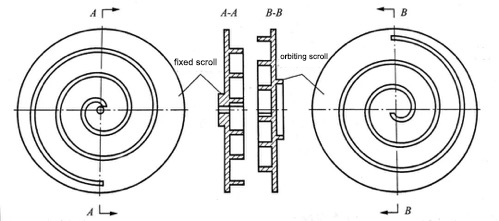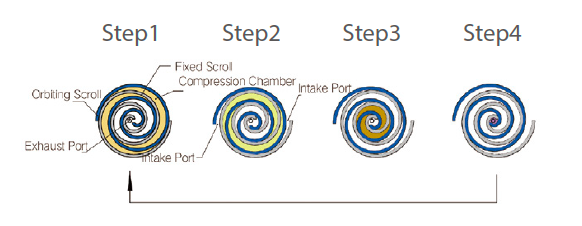A clean vacuum environment has always been the ideal vacuum environment pursued by scientists and enterprises. Since the creation of a vacuum environment, people have tried to use different means to achieve the effect of a clean vacuum. Up to now, clean vacuum obtaining equipment has developed to condense vacuum pumps, plunger vacuum pumps, claw vacuum pumps,
scroll vacuum pumps, and diaphragm vacuum pumps.
The development history of the scroll vacuum pump
The vortex theory was filed by Frenchman Leno Creux in 1905 for a U.S. patent on a reversible scroll expander. However, due to the limited level of processing and manufacturing at that time, the processing accuracy of the scroll profile could not be guaranteed, and the scroll pump was not manufactured for a long period of time. Since the 1970s, the aggravation of the energy crisis and the emergence of high-precision CNC machine tools have brought opportunities for the development of scroll machinery. The research report shows that the scroll compressor has incomparable advantages over other compressors, so the large-scale development and research of the scroll compressor has embarked on the road of rapid development.
With the rapid development of semiconductors, new materials, and biopharmaceutical industries, the continuous maturity of the vortex theory, and the urgent requirement for a clean and oil-free vacuum environment, the vortex vacuum pump has emerged as the times require with its unique advantages. In the early 1980s, the scroll vacuum pump was used in the high vacuum system by Coffin Do because of its good sealing performance and low oil return rate. In 1987, Mitsubishi Electric Corporation of Japan successfully developed the rotary scroll vacuum pump for the first time, which showed absolute advantages in structure and performance. In 1988, the vertical rotary oil-lubricated scroll vacuum pump was successfully developed by Morishita E of Tokyo University in Japan.
The difference between a dry vacuum pump and an oil-lubricated vacuum pump is that the pump chamber does not contain any oil or liquid. Therefore, solving the problems of sealing and cooling in the pump is the key to the research of dry scroll vacuum pumps. In 1990, a horizontal dry scroll vacuum pump with water cooling was successfully developed by Kushiro T. In 1998, a dry scroll vacuum pump with air cooling was successfully developed by Sawada T. Two cooling fans were installed on the main shaft, which was located at the ends of the two static discs.
Dry scroll vacuum pump working principle The
scroll vacuum pump is mainly composed of an orbiting scroll, fixed scroll, anti-rotation mechanism, shell, and other components. Its basic structure is shown in the figure below;
![]()
The orbiting scroll and the fixed scroll rotate 180° relative to each other and are mutually staggered by a certain distance (the distance is the radius of the crankshaft). With the rotation of the crankshaft, the movable scroll is moved in translation to realize the meshing of the scroll teeth of the movable scroll and the fixed scroll. The meshing of the scroll will generate multiple meshing points, forming multiple crescent-shaped closed working chambers. With the rotation of the crankshaft, the meshing moves from the outside to the inside along the spiral tooth wall, so as to realize the crescent-shaped working cavity from large to small gradually to form a periodically changing working cavity volume. At the same time, the gas pressure in the working chamber increases continuously with the rotation of the crankshaft and finally is discharged from the exhaust port at the center of the fixed scroll, so as to realize the suction, compression, and discharge of the gas, and complete the exhaust process of the scroll vacuum pump.
![]()
The pumping process of the
scroll vacuum pump is realized by the meshing motion of the movable scroll and the stationary scroll at all times. Therefore, the design of the scroll is one of the important steps in the development of the scroll vacuum pump, which determines the suction of the scroll vacuum pump. The most important design of the scroll is the design of the scroll profile. In general, the scroll profile of the orbiting scroll and the fixed scroll is the same.
Scroll vacuum pump types and structure
Scroll vacuum pumps can be divided into two types according to the different scroll motion modes, revolution type, and rotary type. One scroll of the pump is fixed and is called a fixed scroll, and the other scroll is an orbiting scroll. The motor drives the crankshaft to rotate, and the crankshaft pushes the center of the base circle of the movable scroll around the base circle of the stationary scroll to make a circular motion of radius r. The anti-rotation structure restricts the movable scroll from rotating.
The two scrolls in the rotary scroll vacuum pump are movable scrolls, and they rotate in the same direction around their own base circle center.
a. Revolution type
The revolution-type
scroll vacuum pump is one scroll that is stationary (fixed scroll) and the other that revolves around it and translates (orbiting scroll). The orbiting scroll is driven by the crankshaft, and the position of the sealing point rotates synchronously with the main shaft. It has a simple overall structure and few parts. The rotary speed of the vortex is small, and the mechanical wear is small, but it needs a dynamic balance design. The scroll vacuum pump uses the outermost scroll ring to contain gas to form a closed suction chamber. In order to reduce the flow conductance between the scroll and the air inlet, the air inlet is set near the end of the outer ring of the scroll. The port is located near the center of the stationary scroll.
b. Rotary type
The rotary-type
scroll vacuum pump consists of two scrolls mounted on the bearings on both sides, one of which is directly driven by a motor, and the other is driven by a cross-slip ring mechanism to rotate in the same direction. Its sealing position forms a line, the direction is always the same, and the pump adopts a vertical structure. The drive motor is in the upper part of the casing, and the scroll is in the lower part. Its overall structure is complex, with many parts and high mechanical wear.
c. Difference between two types
◆Different way of turning
◆Different seal positions and orientations
◆The direction of the gas radial and tangential forces on the scroll is different
◆Different balance
◆Overturning torque and axial force are different
Scroll vacuum pump vacuum range
The vacuum range of a
scroll vacuum pump refers to the range of pressures that the pump is capable of achieving and maintaining. The vacuum range is determined by the pump's design, construction, and operating conditions.
Scroll vacuum pumps can work from atmospheric pressure. The ultimate vacuum of different brands of
scroll vacuum pumps is different, but usually, it can reach 10Pa to 0.5Pa. However, it is important to note that the vacuum range of a scroll vacuum pump can vary depending on factors such as the size of the pump, the type of
scroll pump, and the operating conditions (temperature, oil-free operation, etc.). Additionally, the vacuum range can be affected by factors such as leaks, blockages, or contaminants in the pump or the vacuum system.
Features of scroll vacuum pumps
◆ Small gap, less leakage, and high vacuum degree.
◆ Simple structure and few parts.
◆ The working pressure range is wide. Because the volume of the working chamber changes continuously, the change in driving torque and power is small.
◆ Low vibration noise and high reliability.
◆ Due to the limitation of its own characteristics, the
scroll vacuum pump is not easy to make into a pump with a large pumping rate. At present, the pumping rate of the scroll vacuum pump of some manufacturers can reach 16L/s.
Application of oil-free scroll vacuum pumps
◆Semiconductor industry - thin film preparation equipment, semiconductor packaging equipment;
◆Scientific instrument industry - synchrotron radiation beamlines, electron microscopes, analysis, and testing instruments;
◆Mechanical equipment industry - material preparation equipment, vacuum testing, material purification equipment;
◆Chemical industry;
◆Medical equipment - dental instruments, dialysis machines, biological products, and drug preparation;
◆ Packaging industry - packaging equipment for food, medicine, biological products, etc.
visit for more about the working principle of scroll vacuum pump Dernière modification le mardi 26 Septembre 2023 à 07:52:55
